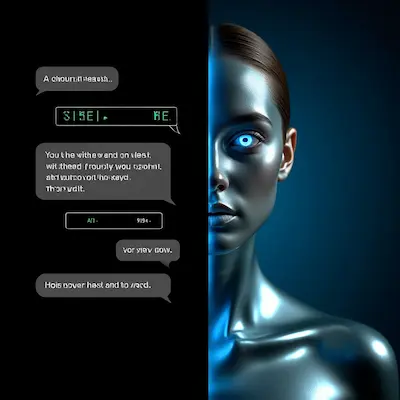Not long ago, interacting with a "chatbot" often meant stilted conversations, keyword-based responses, and frequent frustrating dead ends. But the world of conversational AI in 2025 is a universe apart. Thanks to breakthroughs in Large Language Models (LLMs), natural language understanding (NLU) AI, and even the nascent stages of AI emotional intelligence, we are witnessing the evolution of chatbots into sophisticated digital assistants and even engaging AI digital companions. This post charts this remarkable revolution, exploring what makes today's conversational AI so different and what the future holds for our interactions with these increasingly human-like machines.

1. From Rule-Based to Neural Networks: The Technological Leap
The journey of conversational AI can be broadly categorized:
- Early Rule-Based Chatbots: These were programmed with predefined scripts and keyword matching. If your query didn't fit a rule, the chatbot would likely fail (e.g., "I'm sorry, I don't understand that.").
- Statistical & Early Machine Learning Models: These introduced more flexibility by learning from data, but still had limitations in understanding nuanced language or maintaining long conversations.
- The LLM Revolution (2020s - Present): The advent of powerful LLMs (like those powering ChatGPT, Claude, etc.) trained on vast amounts of text data marked a paradigm shift. These models can:
- Understand context and nuance in language.
- Generate coherent, creative, and grammatically correct text.
- Maintain longer, more natural-sounding conversations.
- Perform a wide range of language tasks (summarization, translation, question answering) within a conversational interface.
This shift to LLMs is the primary driver behind the current capabilities of conversational AI. Our LLM guide for beginners explains more.
2. Natural Language Understanding (NLU) & Generation (NLG): The Core Pillars
Modern conversational AI relies heavily on two subfields of AI:
- Natural Language Understanding (NLU): This is the AI's ability to comprehend human language in all its complexity – including intent, sentiment, entities (like names, dates, locations), and context. Advanced NLU allows AI to understand ambiguous phrasing, slang, and even some forms of sarcasm.
- Natural Language Generation (NLG): This is the AI's ability to produce human-like text that is coherent, grammatically correct, and contextually appropriate. Advanced NLG allows AI to vary its tone, style, and level of detail based on the situation and the user.
In 2025, the synergy between highly capable NLU and NLG is what makes interacting with AI feel increasingly like talking to another human.
3. Context is King: Maintaining Coherent Conversations
A major improvement in conversational AI 2025 is its ability to maintain context over longer interactions. Early chatbots would often "forget" what was said just a few turns ago. Modern systems can:
- Remember Previous Turns: Keep track of earlier parts of the conversation to inform current responses.
- Reference Past Information: Refer back to details mentioned by the user earlier in the dialogue.
- Handle Clarifying Questions: Ask for more information if the user's input is ambiguous, rather than just giving up.
- Manage Complex Dialog Flows: Guide users through multi-step processes or decision trees.
This improved contextual memory (though still with limits, known as the "context window") is crucial for making conversations feel natural and productive.
4. Emerging AI Emotional Intelligence & Empathetic Responses
While true emotions are far beyond current AI, 2025 is seeing significant strides in AI's ability to *recognize* and *respond appropriately* to human emotional cues, often referred to as emerging AI emotional intelligence or affective computing:
- Sentiment Analysis: AI can analyze the text (and sometimes voice tone) to detect positive, negative, or neutral sentiment in the user's input.
- Empathetic Phrasing: Based on detected sentiment, AI can generate responses that sound more empathetic, supportive, or understanding (e.g., "I understand this must be frustrating," or "That sounds exciting!").
- Tone Adaptation: AI can adjust its own communication style to better match the user's perceived emotional state or the context of the conversation.
- Use in Mental Wellness Chatbots: Some AI companions (like Replika or specialized wellness bots) are designed to provide a supportive, non-judgmental listening space, employing empathetic response patterns.
It's critical to remember this is sophisticated pattern matching and generation, not genuine feeling. However, for users, these responses can feel more human and supportive, leading to more engaging AI digital companions. Platforms like Character.ai also leverage this for creating believable personas.
5. Personalization & Adaptability: The AI That Knows You
Conversational AI is becoming increasingly personalized:
- Learning User Preferences: Over time, AI assistants can learn individual user preferences, communication styles, and common requests to provide more tailored and efficient interactions.
- Customizable Personas: Users can often customize the personality, voice, and even the avatar of their AI assistants or companions.
- Integration with Personal Data (with consent): AI can connect with calendars, email, and other personal apps to provide more contextually relevant assistance (e.g., "Remind me about my dentist appointment next Tuesday").
6. Beyond Text: Multimodal Conversational AI
The revolution isn't limited to text. Conversational AI 2025 is increasingly multimodal:
- Voice Assistants (Siri, Alexa, Google Assistant): These are becoming much more conversational, understanding more complex commands and follow-up questions.
- AI Avatars & Embodied AI: Conversational AI integrated into digital avatars or even physical robots that can use gestures, facial expressions (simulated), and voice to interact.
- Understanding Visual Context: AI that can "see" through a camera and discuss what it sees, or understand when a user points to something while speaking.
The Future: Towards More Meaningful Human-AI Dialogue
The evolution of chatbots into sophisticated conversational partners is one of the most exciting frontiers in AI. While challenges like true common-sense reasoning, genuine understanding, and managing ethical concerns (like over-reliance or emotional manipulation) remain, the progress is undeniable. In 2025, we are interacting with AI that can listen, understand, respond, and even "relate" in ways that are transforming customer service, personal assistance, education, entertainment, and companionship. The future of human-computer interaction is undoubtedly conversational, and the "digital companions" of today are just the beginning.
What has been your most impressive or surprising experience with conversational AI?
